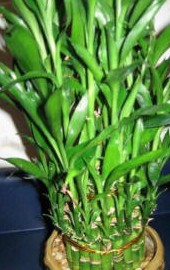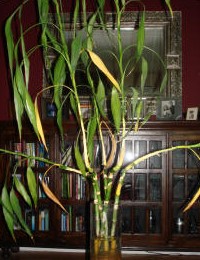
LUCKY BAMBOO
The Bamboo plant has fresh green hues and grows with vigorous tenacity, and has been considered a symbol of good fortune in Asian cultures for at least 4000 years. It has the ability to thrive in a variety of conditions and to adapt to its surroundings.
In the ancient Chinese practice of feng shui, which seeks to create a balanced arrangement of the elements of earth, water, wood, metal, and fire in order to bring harmony to our living environments, bamboo is valued as a perfect representative of wood, with its tall, vertical shape and verdant color. This element is said to have an influence on life energy, growth, vitality and physical activity. Because Lucky Bamboo is able to thrive in many areas of the home or workplace where other plants would not, it is frequently cultivated as a means to enhance the positive flow of energy or "chi" in these areas.
Ironically, the plant which is commonly sold as Lucky Bamboo is in fact a member of the Dracaena family (Dracaena sanderiana), plants which are well known for their durability under adverse indoor conditions. Dracaena is a species, native to Cameroon which is located in tropical west Africa. It a resilient member of the lily family and it belongs to a group of small, shrubby species with slender stems and flexible strap-shaped leaves that grow as ground plants in the rainforests. It is an upright shrub growing to a height of 1.5 metres with leaves 15-25 cm long and 1.5-4 cm broad at the base.
Because of its ease of care and it apparent resemblance to the true bamboos, this Dracaena is now sold in the developed world as a Chinese decorative plant "Lucky Bamboo" (although unrelated to the Bamboo family and not anative to
Why is it called a :LUCKY BAMBOO”
Lucky bamboo (Dracaena Sanderiana) in Traditional Chinese characters are " 富貴竹-FU GUI ZHU" (富貴= rich & lucky; 竹=bamboo). When it was introduced to the out side world by
Lucky Bamboo belongs to the Wood category of the five elements of Feng Shui, so it is suggested to place the bamboo on the east side of your residence or the office.
The number of stalks also has meaning : Single or two stalks are not considered to be lucky.
Three stalks mean happiness, five stalks mean wealth and six stalks mean health.
Four stalks, however, are always avoided since the word "four" in Chinese sounds too similar to the Chinese word for "death"! The bunch may contain than six stalks as these are considered very lucky.
Tips for choosing a healthy Lucky Bamboo:
Press the stem between your fingures;it must be firm.
Check roots; the more fine roots in the roots system, the better.
Check by smelling - a healthy bamboo has a fresh smell, and no black spots on the bottom tip.
Check the leaves to make sure they are thick and dark green
Tips for the care of the Lucky Bamboo:
The water should be completely changed every two weeks. The water used should be distilled water, filtered water or soft tap water with very little fluoride and chlorine. If using tap water, it should be kept exposed to the air for a day so that the florurine and chloride are nutrialised.
It grows best in bright, indirect lighting and temperatures above 15 °C up to 25 °C.
If it is exposed to direct sunlight for long durations or the water used is contaminated with flouride or chlorine the leaves turn Yellow or brown at the edges. Salty or softened water can also cause this.
1. Keep the plant away from fluoridated or chlorinated water; exposing the tap water for more than 24 hour before you add water. We recommend distilled water or spring water.
2. Water is always at least one inch higher than the roots; you should replace all water if there is any growth of moss in the water.
3. Direct sun light will evaporate water inside the plant quickly and make the leaves turn brown.
4. Place lucky bamboo in a space with flow fresh air can help the plant grow and be healthy.
5. Clean dust on the surface of the leaves by mist spray as this helps the plant to breathe better and photosynthesis..
6. Wash all roots and trim the dead ones ever 2-3 months when you change the water, before putting lucky bamboo in the container and adding fresh water. If by mistake you have over trimmed the roots do not worry; the root system will generate new roots very soon.
Propagtion:
It is propagated in nature through root culture but in the nursery or at home, it is propagated from the canes which are harvested and cut into much smaller lengths of 10 to 20 cm. The tops of the canes are coated with wax so that the fungus or rot does not effect it. The canes are then bunched together and tied with a red band or ribbon. Place the new bunched up cutting in a small glass container with some pebbles or gel to keep them upright. Soon in 10-15 days fresh roots will appear at the bottom tips of the canes.
It is mainly grown verticle in the containers but beautifull twisted shapes can be produced by rotating the plant with respect to gravity and directed light sources. This is difficult to achieve for most home gardeners, but not impossible if you have the patience and time.
You can give a a variety of shapes to your lucky bamboo. As you know, the plants are always reaching towards the sky the gardener first inclines the bamboo stalk and fixes it at an angle of 15 to 20 degrees to the earth's surface. The top of the plant will reach toward the sun, on the second turn of the plant, tip the plant 90 degrees so this new growth is parallel to the earth (0 degrees). The top of the plant will again toward the sun. To get a spiral with two rings, the gardener next turn the plant 9 times. This process is completed in about110 to 120 days.
Fertilisation:
The Lucky Bamboo plants survive and grow without application of any fertilizers. They generate their food through the chlorophyll route from the sunlight. However, if the plants are not growing and are becoming unhealthy you can add the normal household liquid fertilizers at 10 percent strength. Be sure not add more than 5-6 drops of it to each container.
